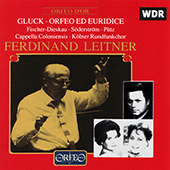Elisabeth Söderström
Söderström’s father was a tenor manqué who instead went into business and her mother was a Russian-born pianist who had escaped from St Petersburg during the 1917 Revolution; the singer recalled how in her childhood the family home was filled with music. Her initial intention was to become an actress, but on rejection by the Stockholm Academy of Dramatic Arts she turned to singing, studying with Adelaide von Skilondz, a leading coloratura soprano of the St Petersburg Imperial Opera and the Berlin Court Opera (who advised her to avoid singing Verdi and Wagner) and at the Royal Swedish Academy of Music in Stockholm. While still a student there she appeared as a Shepherdess / The Queen of Spades and became known for success in trouser roles, using experience from watching her boyfriends.
In 1947 Söderström made her operatic stage debut at the Drottningholm Court Theatre as Bastienne / Bastien und Bastienne (Mozart), followed by another appearance the following year in Grétry’s Le Tableau parlant. She joined the Royal Swedish Opera in 1949, remaining a member of this company until 1980 while also spending substantial periods of time abroad. Amongst the many roles which she sang with the RSO and elsewhere were: Pamina / Die Zauberflöte; Susanna and the Countess / Le nozze di Figaro; Sophie, Octavian and the Marschallin / Der Rosenkavalier; Nero / L’incoronazione di Poppea; Mélisande / Pélleas et Mélisande; Ellen / Peter Grimes; Violetta / La traviata; the four soprano roles in Les Contes d’Hoffmann; Regina / Mathis der Maler; the title roles in Louise, Jenůfa and Kát’a Kabanová, and Emilia Marty / The Makropulos Case; Tatyana / Eugene Onegin; Mimì / La Bohème and Euridice / Orfeo ed Euridice. She also sang in a number of first performances of modern operas.
At the Salzburg Festival Söderström first appeared in 1955 as Ighino / Palestrina and in 1957 she made the first of many appearances at the Glyndebourne Festival as the Composer / Ariadne auf Naxos, followed by Octavian and Susanna (1959), Elisabeth Zimmer / Elegy for Young Lovers (Henze) (1961), the Countess / Capriccio (1963), Frau Storch / Intermezzo (1974) and Leonore / Fidelio (1979). Her debut at the Metropolitan Opera, New York came in 1959 as Susanna; Söderström sang there regularly until 1964 when she based herself in Sweden for the sake of her children’s schooling. Other Met roles at this time included Marguerite / Faust, Sophie (both from 1959), Adina / L’elisir d’amore, Musetta / La Bohème (from 1960), Rosalinde / Die Fledermaus (1962) and the Composer (1964). Later, between 1983 and 1987, she returned to the Met to sing the Marschallin, Ellen, and the Countess (Figaro).
Söderström had first appeared at the Royal Opera House, London in 1960 with the Royal Swedish Opera as Daisy Doody / Aniara (Blomdahl) and made her debut with the Covent Garden Opera in 1967 as the Countess (Figaro). In 1969 she sang Fiordiligi / Così fan tutte, with Charles Mackerras conducting, which resulted in a close working relationship. This was followed at the end of 1969 by possibly her greatest Covent Garden role, Debussy’s Mélisande with Pierre Boulez conducting, an interpretation of unparalleled intensity.
Her career entered a strong second phase marked by a close identification with the operas of Janáček: she sang Jenůfa at the Edinburgh Festival in 1974 and in 1982 made her Australian debut at the Adelaide Festival as Emilia Marty, which she also sang with the Welsh National Opera. Söderström also created the parts of Amanda/Clitoria / Le Grande Macabre (Ligeti) at Stockholm in 1978 and of Juliana Bordereau / The Aspern Papers (Argento) at Dallas in 1988.
Poulenc’s La Voix humaine saw Söderström’s final performances at the Edinburgh Festival in 1992. She served as artistic director of the Drottningholm Festival (1993–1996) and, although having formally retired in 1997, made her very final appearance at the Met as the Countess / The Queen of Spades in 1999, by which time her eyesight was weakening. She also directed, gave master-classes and sat on singing competition juries. Söderström received numerous honours, including giving her name to a Eurostar locomotive in 1997. She sang frequently in concert and was an accomplished recitalist: one partner, Vladimir Ashkenazy, aptly described her as ‘the sunshine of my generation’.
Söderström was indeed one of the most distinguished singers of her generation, combining a vibrant voice, great emotional identification with all she sang, and a personality of exceptional kindness and humour. Her recordings of the major Janáček operas with Mackerras conducting remain particularly powerful, as does her Mélisande with Boulez. As one critic described her Glyndebourne Capriccio Countess in 1964: ‘Her singing was superfinely moulded in line and radiant in tone, yet always richly expressive as well as ravishing.’
© Naxos Rights International Ltd. — David Patmore (A–Z of Singers, Naxos 8.558097-100).


















